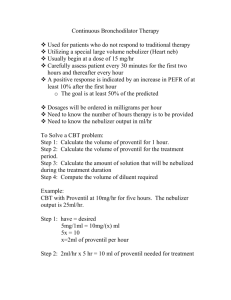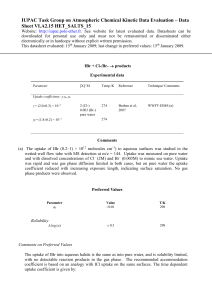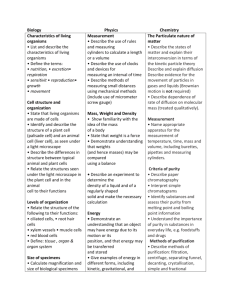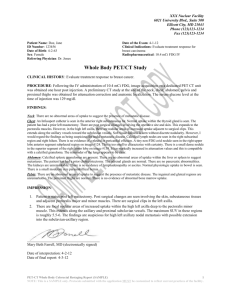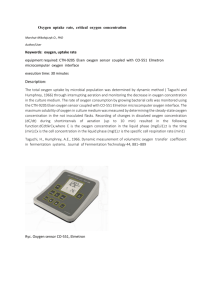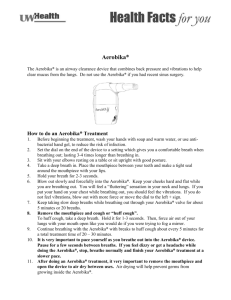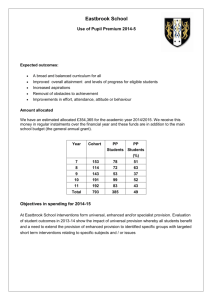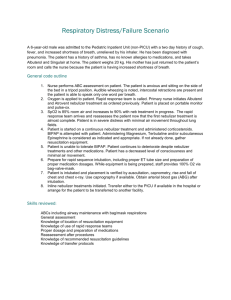Approaching a Universal Pneumatic Nebulizer
advertisement
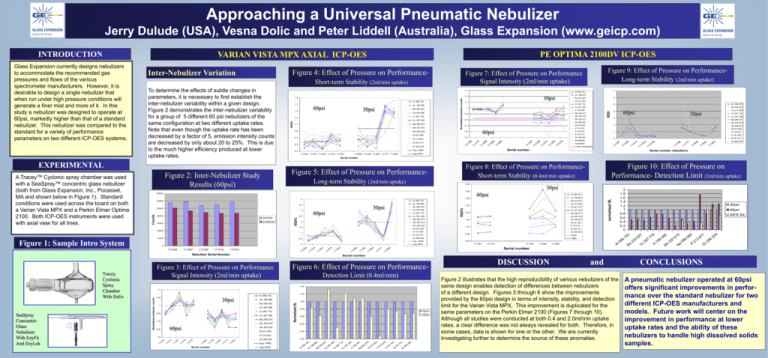
Approaching a Universal Pneumatic Nebulizer Jerry Dulude (USA), Vesna Dolic and Peter Liddell (Australia), Glass Expansion (www.geicp.com) PE OPTIMA 2100DV ICP-OES VARIAN VISTA MPX AXIAL ICP-OES EXPERIMENTAL 111230 111314 111307 111219 111333 Mg 280.271 Mn 257.610 2 Mo 202.031 Ni 231.604 S 181.975 1 S 181.975 Si 251.611 0 Linear (Average60) Serial number Serial number nebulizers Serial number Figure 10: Effect of Pressure on Performance- Detection Limit (2ml/min uptake) Figure 8: Effect of Pressure on PerformanceShort-term Stability (0.4ml/min uptake) 4.00 30psi 2 1.8 1.6 1.4 1.2 1 0.8 0.6 0.4 0.2 0 3.50 60psi Al 396.152 Cr 267.716 Cu 327.395 Mg 280.270 2 Mo 202.032 Avg.AR30 3 Detection Limit (0.4ml/min) 1.40 1.20 As 188.980 1 Ca 393.366 Cr 267.716 0.95 Cu 327.395 Mg 280.270 Mn 257.610 60psi 0.80 30psi 60psi 0.60 0.40 Mo 202.032 Ni 231.604 0.20 P 213.618 n 20 6. 20 0 .6 11 Z S i2 51 97 2 S 18 3. 1. 61 8 4 21 P 31 .6 0 27 0 N i2 M g 76 28 6. 0. 49 1 5 39 K 32 7. 71 C u 26 7. C r 39 3. 36 6 6 03 C a 5. 4 8. 45 B a Avg.AR30 18 Avg. AR60 98 0 .1 52 0.00 A s Serial number Zn 206.200 96 11 16 86 11 17 80 11 16 54 11 17 77 11 16 53 0.8 A l3 0.85 1.00 Normalized DL Ba 455.403 11 12 30 11 13 14 11 13 07 11 12 19 11 13 33 Normalised emission counts Al 396.152 0.9 Si 251.611 Zn 206.200 0.50 Avg30 Avg60 0.00 111333 111219 111780 111686 MFR IDL 111654 11 Figure 6: Effect of Pressure on Performance- 1.1 30psi P 213.617 1.00 60psi Serial number Figure 3: Effect of Pressure on Performance Signal Intensity (2ml/min uptake) 1.05 Ni 231.604 30psi Serial number 16 5 7 11 17 7 4 11 16 5 0 17 8 6 Nebulizer Serial Number 11 11 16 8 3 11 13 3 9 11 12 1 7 13 0 11 11 11 111314 13 1 0 12 3 4 0 111219 Mo 202.031 1.50 Zn 206.200 Avg. AR60 111230 Mn 257.610 P 213.618 0.5 111307 Mg 280.271 Ni 231.604 Si 251.611 111333 Cu 327.393 2.00 Mn 257.610 1 0 Cr 267.716 l3 96 .1 53 B a 23 3. 52 7 C r2 67 .7 16 K 76 6. 49 M 0 n 25 7. 61 N 0 a 58 9. 59 2 P 21 3. 61 7 Zn 20 6. 20 0 60psi 2.5 RSD% Ca 393.366 RSD% 3 Ca 317.933 2.50 Ba 455.403 A 30psi 250000 Figure 1: Sample Intro System Ba 233.527 As 188.980 3.5 50000 As 188.979 3.00 4 300000 200000 Al 396.153 normalized DL 350000 150000 Zn 206.200 Avg.AR30 111686 111780 111654 111777 111653 Long-term Stability (2ml/min uptake) 2ml/min 0.4ml/min 11 16 53 Average30 11 16 86 11 16 54 Average60 11 17 80 11 17 77 19 11 12 33 13 11 13 11 86 16 77 11 17 80 11 17 P 213.617 Si 251.611 Zn 206.200 Avg. AR60 0.3 100000 SeaSpray Concentric Glass Nebulizer With EzyFit And EzyLok 60psi 11 Zn 206.200 Cu 327.393 P 213.617 0.5 Si 251.611 0.5 Cr 267.716 3 Ni 231.604 0.7 0.6 P 213.618 30psi Na 589.592 Ni 231.604 0.7 Ca 317.933 60psi 11 12 30 11 13 14 11 13 33 a 11 12 19 a Mo 202.032 0.8 30 0.9 4 Mo 202.031 12 Mn 257.610 Mn 257.610 11 Mg 280.270 1.1 0.9 07 Cu 327.395 Mg 280.271 13 1.3 Ba 233.527 K 766.490 11 Cr 267.716 1 53 Ca 393.366 As 188.979 5 Cu 327.393 16 30psi Ca 317.933 Cr 267.716 11 1.5 Ba 455.403 6 Ba 233.527 1.1 54 60psi 30psi 16 As 188.980 1.5 Tracey Cyclonic Spray Chamber With Helix As 188.979 11 1.7 Normalised emission counts Al 396.152 7 Al 396.153 1.2 1.9 Figure 5: Effect of Pressure on Performance- Figure 2: Inter-Nebulizer Study Results (60psi) Counts A Tracey™ Cyclonic spray chamber was used with a SeaSpray™ concentric glass nebulizer (both from Glass Expansion, Inc., Pocasset, MA and shown below in Figure 1). Standard conditions were used across the board on both a Varian Vista MPX and a Perkin Elmer Optima 2100. Both ICP-OES instruments were used with axial view for all lines. 1.3 RSD Short-term Stability (2ml/min uptake) To determine the effects of subtle changes in parameters, it is necessary to first establish the inter-nebulizer variability within a given design. Figure 2 demonstrates the inter-nebulizer variability for a group of 5 different 60 psi nebulizers of the same configuration at two different uptake rates. Note that even though the uptake rate has been decreased by a factor of 5, emission intensity counts are decreased by only about 20 to 25%. This is due to the much higher efficiency produced at lower uptake rates. Figure 9: Effect of Pressure on PerformanceLong-term Stability (2ml/min uptake) Figure 7: Effect of Pressure on Performance Signal Intensity (2ml/min uptake) 11 13 07 Figure 4: Effect of Pressure on Performance- Inter-Nebulizer Variation RSD% Glass Expansion currently designs nebulizers to accommodate the recommended gas pressures and flows of the various spectrometer manufacturers. However, it is desirable to design a single nebulizer that when run under high pressure conditions will generate a finer mist and more of it. In this study a nebulizer was designed to operate at 60psi, markedly higher than that of a standard nebulizer. This nebulizer was compared to the standard for a variety of performance parameters on two different ICP-OES systems. 14 INTRODUCTION DISCUSSION and Figure 2 illustrates that the high reproducibility of various nebulizers of the same design enables detection of differences between nebulizers of a different design. Figures 3 through 6 show the improvements provided by the 60psi design in terms of intensity, stability, and detection limit for the Varian Vista MPX. This improvement is duplicated for the same parameters on the Perkin Elmer 2100 (Figures 7 through 10). Although all studies were conducted at both 0.4 and 2.0ml/min uptake rates, a clear difference was not always revealed for both. Therefore, in some cases, data is shown for one or the other. We are currently Investigating further to determine the source of these anomalies. CONCLUSIONS A pneumatic nebulizer operated at 60psi offers significant improvements in performance over the standard nebulizer for two different ICP-OES manufacturers and models. Future work will center on the improvement in performance at lower uptake rates and the ability of these nebulizers to handle high dissolved solids samples. printed by www.postersession.com
